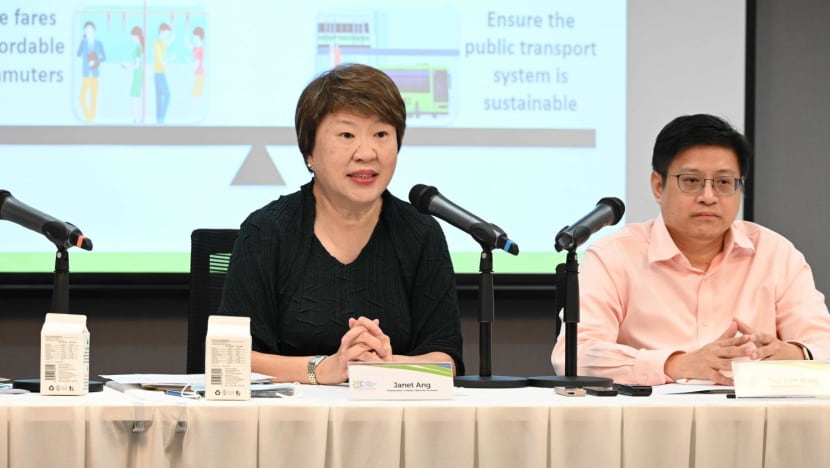Public Transport Council tweaks fare formula amid inflation, changing commuter patterns
The Public Transport Council says the revised formula reduces volatility and ensures fare affordability, while keeping the public transport system financially sustainable.
SINGAPORE: The formula used to determine public transport fares has been adjusted to include two fixed components to reduce swings in fare changes.
The Public Transport Council (PTC) announced this on Tuesday (Apr 25) after its latest review of the formula, which is conducted every five years.
The revised formula will be used for this year’s fare review, likely in the fourth quarter.
The 2018-2022 formula was made up of five components - the core consumer price index (cCPI), a wage index (WI), energy index (EI), productivity extraction (PE) and network capacity factor (NCF).
For the new formula, the last two components have been tweaked and given fixed values to reduce volatility.
Productivity extraction will be changed to productivity contribution (PC), and NCF to the capacity adjustment factor (C).
THE PRODUCTIVITY COMPONENT
Productivity contribution or PC will be fixed at minus 0.1 per cent for the next five years.
“Whatever the fare adjustment quantum spits out, we will minus 0.1 (per cent). So you can see that as the public transport operators’ contribution to our goal of ensuring fare affordability,” explained PTC chair Janet Ang.
The PTC said that the productivity contribution is to "maintain the expectation for public transport operators to strive for continuous productivity improvements". This means operators will have to strive to improve productivity to offset the 0.1 per cent fare reduction.
During the COVID-19 pandemic, the transport operators’ productivity gains would have been negative without government support, and the PE was zero.
The PTC said it is important for public transport operators to be cost-efficient and improve productivity, and share those gains with commuters. Thus, retaining the component is a signal to public transport operators to strive for continuous productivity improvements.
The fixed amount was derived from previous performance before COVID-19.
During the review of the fare adjustment formula in 2018, the PE was set at 0.1 per cent, based on half of the productivity savings realised by the public transport operators between 2012 and 2016.
What goes into the new formula?
OLD FORMULA:
0.5 cCPI (core consumer price index) + 0.4 WI (wage index) + 0.1 EI (energy index) – PE (productivity extraction) + NCF (network capacity factor)
NEW FORMULA:
0.5 cCPI + 0.4 WI + 0.1 EI – PC (productivity contribution) + C (capacity adjustment factor)
cCPI = Year-on-year change in core consumer price index
WI = Year-on-year change in wage index measured by the Average Monthly Earnings (National Average)
EI = Year-on-year change in energy index which is a composite index derived from diesel and electricity prices
PC = Productivity contribution set at 0.1 per cent
C = Capacity adjustment factor set at 1.1 per cent, based on actual and planned capacity improvements from 2020 to 2026. This 1.1 per cent largely reflects the improved connectivity and lower journey times arising from the opening of the Thomson-East Coast Line.
THE CAPACITY COMPONENT
The capacity adjustment factor or C will be fixed at 1.1 per cent, also for five years.
This is based on actual and planned capacity improvements from 2020 to 2026, including the opening of the Thomson-East Coast Line.
Compared with the NCF - which tracks operating costs due to network capacity changes relative to ridership - this reduces variability due to capacity and ridership changes.
Explaining why the NCF was modified, the PTC said that the NCF was not designed to track short-term fluctuations in demand and supply during exceptional periods such as the COVID-19 pandemic.
The drastic fall in ridership over the COVID-19 pandemic period resulted in significantly higher NCF values, and NCF contributions were excluded in the computation of fare adjustment quantums in the last two years.
The NCF assumed steady commuting patterns, and triggers fare increases if there is an expansion in the public transport network less than a commensurate increase in ridership, so with ridership plummeting during COVID-19, there would have been a drastic increase in transit fares, said Assistant Professor Terence Fan of the Singapore Management University.
"In view of the new rail lines and improved bus services, this (1.1 per cent) increase is reasonable," he said.

PTC chief executive Tan Kim Hong said that the purpose and intent are the same - to cover part of the increase in cost due to capacity improvement.
What is different is the operating environment has changed, he said, adding that the NCF included the ridership then because it was more stable.
While ridership has recovered to about 90 per cent of pre-pandemic levels, commuter patterns have changed.
The fare review report said that public transport journeys in the morning peak to Woodlands and Tuas are already back to pre–COVID levels but journeys to the downtown core are at about 70 per cent.
Due to adjustments in work practices, ridership and travel patterns may not have fully stabilised yet, the report said.
INFLATION, WAGES, ENERGY
The other three components - the core consumer price index, wage index and energy index - and their weightage reflect the operating cost structure of the public transport industry. They remain unchanged.
Ms Ang said that transport operators are faced with 14-year-high inflation, volatile energy prices and rising manpower costs, while ridership post-COVID remains unclear.
Taken as a whole, the recommendations will help reduce volatility and ensure fare affordability, while keeping the public transport system financially sustainable, said Ms Ang.
“To monitor affordability, PTC tracks the public transport affordability indicator. Over the past decade, the public transport fare affordability has improved, and commuters now spend a lower share of household income on public transport,” she said.
She added that the fare adjustment formula provides a clear and objective basis for fare adjustments, but it can defer fare adjustments to future years when economic and social realities warrant it.
Last year, while the fare adjustment formula allowed for a maximum fare increase of 13.5 per cent, the PTC granted public transport operators a fare increase of 2.9 per cent due to concerns over the rising cost of living.
The remaining 10.6 per cent will be carried over to this year’s review and future fare review exercises.
WILL FARES INCREASE?
In response to questions on whether public transport fares will go up this year, given the 10.6 per cent rollover from last year and continued inflationary pressure, Mr Tan said that the formula is used to derive the maximum quantum for any fare hike, but there is a mechanism to moderate this taking into consideration social and economic factors.
“We have to look at the situation then and for PTC to then recommend what would be an appropriate amount taking into consideration sustainability and affordability,” said Mr Tan.
Analysts said that the two fixed components now translate to an expected 1 per cent increase each year if all else remains constant but the other components – in particular energy prices – remain in flux.
Economist and transport analyst Walter Theseira said he expects public transport fares to rise “substantially and consistently” over the next five years as the large quantum that was deferred has to be factored in, and inflation has been substantial.
“Barring very very sharp deflation, it is not likely that fares would go down or even increase only slightly,” said the associate professor from the Singapore University of Social Sciences.
Associate Professor Raymond Ong from the National University of Singapore said it remains to be seen as this review was for deciding on the formula and not the fare increase.
“We can reduce the volatility … (for) the productivity contribution and also, the capacity adjustment. But for those factors that are tied to market conditions, I think we still have to observe their effect on the fares,” he said.
But all agreed that the government is likely to cushion the impact of any increase. Assistant Professor Fan said the PTC has a history of limiting the amount of one-time increases, so hopefully it will continue to do so.
“The fare formula is just a way of keeping the commuter share of the cost stable. The rest comes from government, and we can expect that government will continue to backstop the system and to manage affordability through targeted subsidies and also support for managing spikes in the fare formula,” added Assoc Prof Theseira.
He added that it would be a political decision as to how to implement the large fare adjustments that were carried over from last year and which are likely to happen this year.
The government has accepted the PTC’s recommendations and the proposed fare formula, said the Ministry of Transport.
The ministry said that the government will do its part to ensure that public transport remains affordable. On top of funding public transport infrastructure, it continues to subsidise part of operating costs at more than S$2 billion annually.
“Maintaining a high-quality, affordable and financially sustainable public transport system is the shared responsibility of the government, public transport operators and commuters,” said Minister for Transport S Iswaran.
“The PTC’s recommendations aim to maintain the balance between fare affordability and the financial sustainability of the public transport system, and help reduce volatility for both public transport operators and commuters.”















